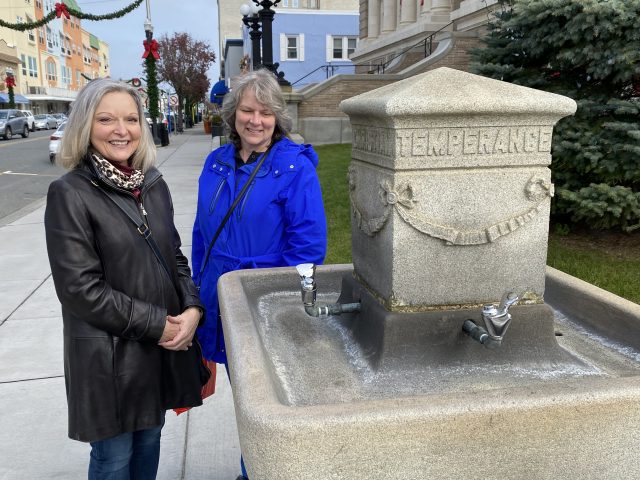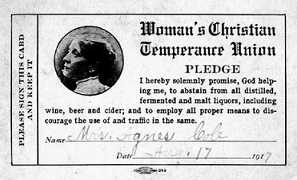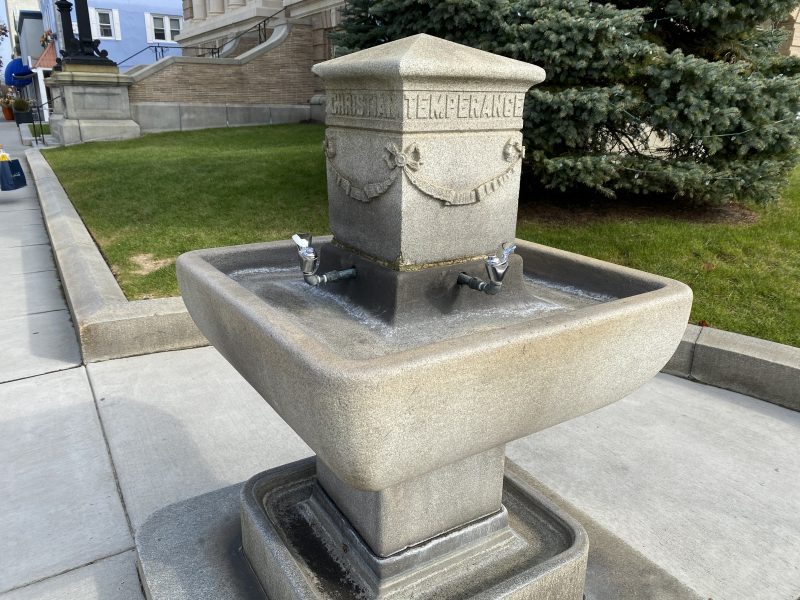
By TIM KELLY
Like most pedestrians strolling past City Hall on a recent late fall day, Carla Samson and Kristen Drake walked right past the historic “Temperance Fountain” without so much as a second look.
“I’ve noticed it before and I always wondered what it was,” said Samson, of Milford, Pa., who was in town with her friend Kristen Drake for a day of shopping.
She’s not alone. The elegant 107-year-old granite fountain, located on the northeast corner of Ninth Street and Asbury Avenue, was one of thousands of varying sizes and designs installed around the country by the Woman’s Christian Temperance Union. The local fountain is one of several hundred still in existence.
“I was one of those people myself who did not really know about the fountain’s story,” said Ocean City historian and author Fred Miller. “Once I did some research on it, I thought this is pretty cool. It has been here quite a long time.”
Donated as part of the WCTU’s campaign encouraging citizens to consume water as a healthy alternative to alcohol and to promote abstinence, the fountains gained popularity in the early part of the 20th century.
At that time, political and social forces were moving toward enactment of the Volstead Act, a law enforcing the 18th Amendment to the Constitution. Commonly known as Prohibition, the nationwide ban on alcohol began on January of 1920 and will officially mark its 100th anniversary on Jan. 16.
Prohibition ran from 1920 to 1933. On Dec. 5, 1933, ratification of the 21st Amendment repealed the 18th Amendment and Americans were allowed to legally drink again.
It stands to reason that Ocean City, which has prohibited the public sale and consumption of alcohol since the town’s founding by Methodist ministers in 1879, would embrace the donation of the Temperance Fountain. Well, not quite, said Miller.
“They tried to present it to the city in 1912, but it wasn’t put up until three years later,” Miller explained. He said then-Mayor Harry Headley would accept the donation only when City Hall, which was then under construction, was completed.
That is why there is a three-year difference between the January 1915 completion of City Hall and the “1912” date chiseled onto the fountain, Miller said.
The landmark stands close to six feet tall and includes a trough just above the sidewalk designed for use by dogs, he added. The city refurbished it and upgraded the plumbing and fountain hardware in advance of its centennial.
“It was restored and repaired. Not many towns have something like this. It’s really nice to have something like this in Ocean City,” Miller remarked.

Joyce Powell, of Bridgeton, the current Woman’s Christian Temperance Union state president, said she helped organize a bus trip among the membership to visit Ocean City’s fountain on its 100th anniversary in 2012.
“We had two busloads and a carload of people,” she said. “A lot of (members) and their families were interested enough to take the trip. These days, we have a harder time getting the younger people to join and to carry on the tradition.”
Powell herself recently resumed activities with the organization following a months-long hiatus to battle health problems.
“I’m back and fighting for the cause and doing as much as I can,” she said. “We believe in moderation in all healthy things and complete and total abstinence from all things that are harmful to the human body.”
The use of “woman’s” in the organization’s name and not “women’s” stems from the fact that each member takes a pledge of temperance before they are accepted into the group, Powell said.
Curiously, the Ocean City fountain carries the inscription “WOMENS CHRISTIAN TEMPERANCE UNION.”
Nowadays the WCTU, one of the first national lobbying organizations of any kind, has expanded that message to include the opioid epidemic and to be a leading voice against vaping and e-cigarettes, according to its website.
Around the time of the fountain’s donation in Ocean City, Powell said the group was a loud local opponent of tobacco, and an advocate of “blue laws” banning leisure activities and placing restrictions on businesses on Sundays.
“But the main thing we were fighting against was alcohol,” she said.
In May of 2012, Ocean City voters defeated a “BYOB” referendum proposal to allow public consumption of alcohol in city restaurants by a resounding 2-1 margin. Opponents stressed the resort’s marketing brand, largely based on attracting families to visit a mostly alcohol-free environment.
Despite this, liquor superstores thrive at the foot of two bridges on the outskirts of the island, and several private clubs around town legally operate full-service bars. In the years following the defeat of the BYOB referendum, several businesses have been approved by the city to open “supper clubs,” where dinner patrons may bring their own alcohol.
Such caveats to Ocean City’s “dry” status are not new. During Prohibition, speakeasies operated around town, including a cavernous one in the basement of the Flanders Hotel. Bootleggers operated on the island and across the bay in Somers Point.

Still, the temperance drumbeat has a strong audience here and that will continue, Powell said.
“As long as we have a voice, we’re going to use it,” she vowed.
Which brings us back to Ocean City’s fountain.
“Shortly after City Hall opened and the fountain was installed, Headley was defeated in the mayoral election (by Joseph Champion), because people apparently thought he spent too much money on City Hall,” Miller said.
The Woman’s Christian Temperance Union had been heard loud and clear. By the time of the next mayoral election, the first ripple effect of the campaign had taken place: Women finally were given the right to vote.





